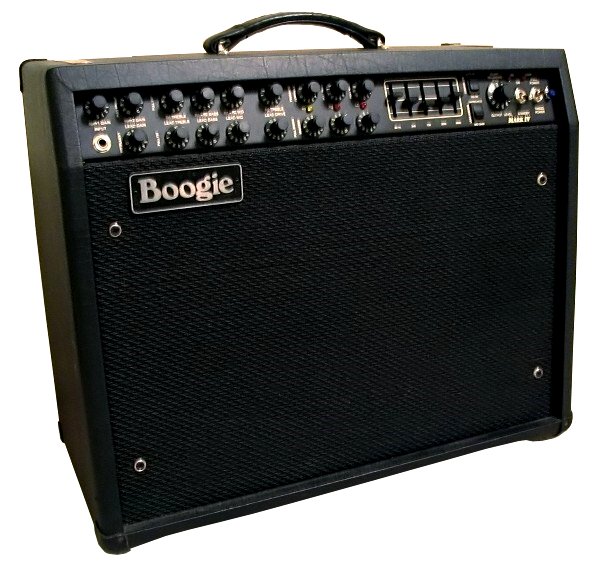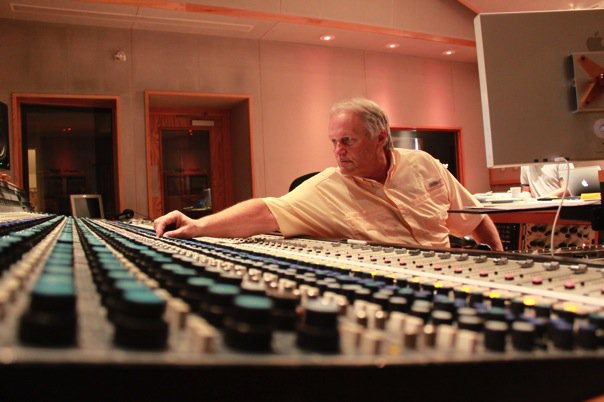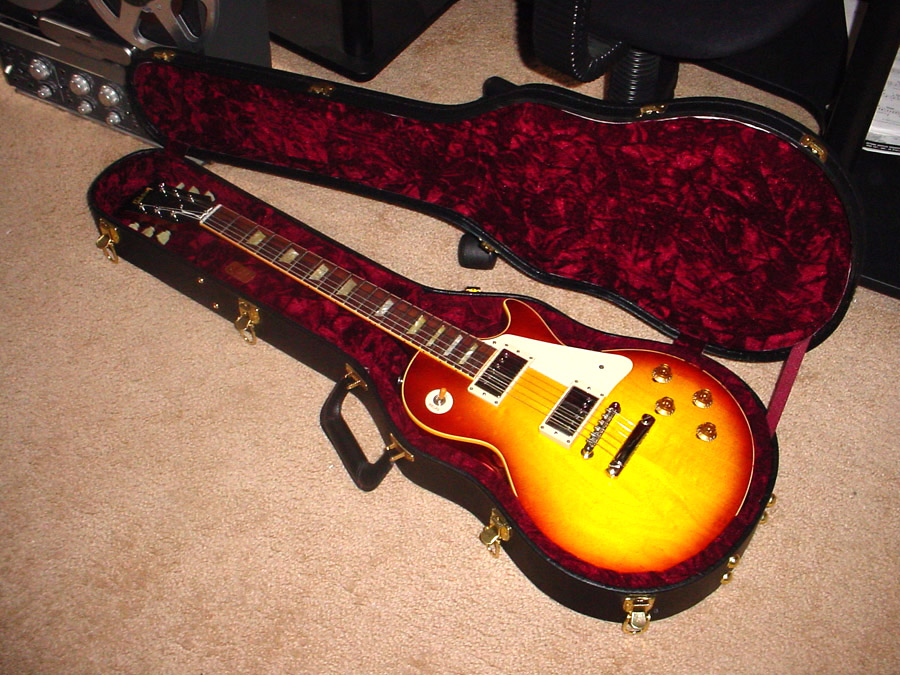|
Re-amp
Re-amping is a process often used in multitrack recording in which a recorded signal is routed back out of the editing environment and run through external processing using effects units and then into a guitar amplifier and a guitar speaker cabinet or a reverb chamber. Originally, the technique was used mostly for electric guitars: it facilitates a separation of guitar playing from guitar amplifier processing—a previously recorded audio program is played back and re-recorded at a later time for the purpose of adding effects, ambiance such as reverb or echo, and the tone shaping imbued by certain amps and cabinets. The technique has since evolved over the 2000s to include many other applications. Re-amping can also be applied to other instruments and program, such as recorded drums, synthesizers, and virtual instruments. Examples of common re-amping objectives include taking a pre-recorded electric guitar track and adding musically pleasing amplifier distortion/overdrive, room ... [...More Info...] [...Related Items...] OR: [Wikipedia] [Google] [Baidu] |
Guitar Amplifier
A guitar amplifier (or amp) is an electronic amplifier, electronic device or system that strengthens the electrical signal from a Pickup (music technology), pickup on an electric guitar, bass guitar, or acoustic guitar so that it can produce sound through one or more loudspeakers, which are typically housed in a wooden speaker enclosure, cabinet. A guitar amplifier may be a standalone wood or metal cabinet that contains only the power amplifier (and preamplifier) circuits, requiring the use of a separate speaker cabinet–or it may be a ''combo'' amplifier, which contains both the amplifier and one or more speakers in a wooden cabinet. There is a wide range of sizes and power ratings for guitar amplifiers, from small, lightweight practice amplifiers with a single 6-inch speaker and a 10-watt amp to heavy combo amps with four 10-inch or four 12-inch speakers and a 100-watt amplifier, which are loud enough to use in a nightclub or bar performance. Guitar amplifiers can also modify ... [...More Info...] [...Related Items...] OR: [Wikipedia] [Google] [Baidu] |
Distortion (music)
Distortion and overdrive are forms of audio signal processing used to alter the sound of amplified electric musical instruments, usually by increasing their gain (electronics), gain, producing a "fuzzy", "growling", or "gritty" tone. Distortion is most commonly used with the electric guitar, but may be used with other instruments, such as bass guitar, electric bass, electric piano, synthesizer, and Hammond organ. Guitarists playing Chicago blues, electric blues originally obtained an overdriven sound by turning up their vacuum tube-powered guitar amplifiers to high volumes, which caused the signal to clipping (audio), distort. Other ways to produce distortion have been developed since the 1960s, such as distortion effects unit, effect pedals. The growling tone of a distorted electric guitar is a key part of many genres, including blues and many rock music genres, notably hard rock, punk rock, hardcore punk, acid rock, grunge and heavy metal music, while the use of distorted bas ... [...More Info...] [...Related Items...] OR: [Wikipedia] [Google] [Baidu] |
Audio Engineer
An audio engineer (also known as a sound engineer or recording engineer) helps to produce a recording or a live performance, balancing and adjusting sound sources using equalization, dynamics processing and audio effects, mixing, reproduction, and reinforcement of sound. Audio engineers work on the "technical aspect of recording—the placing of microphones, pre-amp knobs, the setting of levels. The physical recording of any project is done by an engineer…" Sound engineering is increasingly viewed as a creative profession and art form, where musical instruments and technology are used to produce sound for film, radio, television, music and video games. Audio engineers also set up, sound check and do live sound mixing using a mixing console and a sound reinforcement system for music concerts, theatre, sports games and corporate events. Alternatively, ''audio engineer'' can refer to a scientist or professional engineer who holds an engineering degree and designs, deve ... [...More Info...] [...Related Items...] OR: [Wikipedia] [Google] [Baidu] |
DI Unit
A DI unit (direct input or direct inject) is an electronic device typically used in recording studios and in sound reinforcement systems to connect a high output impedance unbalanced output signal to a low-impedance, microphone level, balanced input, usually via an XLR connector and XLR cable. DIs are frequently used to connect an electric guitar or electric bass to a mixing console's microphone input jack. Its signal comes "direct" from the source instrument without passing through the air as sound waves, and thus is isolated from other sounds and avoids effects of microphone or room acoustics. The DI performs level matching, balancing, and either active buffering or passive impedance matching or impedance bridging. DI units are typically metal boxes with input and output jacks and, for more expensive units, “ground lift” and attenuator switches. DI boxes are extensively used with professional and semi-professional PA systems, professional sound reinforcement systems a ... [...More Info...] [...Related Items...] OR: [Wikipedia] [Google] [Baidu] |
Multitrack Recording
Multitrack recording (MTR), also known as multitracking, is a method of sound recording developed in 1955 that allows for the separate recording of multiple sound sources or of sound sources recorded at different times to create a cohesive whole. Multitracking became possible in the mid-1950s when the idea of simultaneously recording different audio channels to separate discrete ''tracks'' on the same reel-to-reel tape was developed. A ''track'' was simply a different channel recorded to its own discrete area on the tape whereby their relative sequence of recorded events would be preserved, and playback would be simultaneous or Synchronization, synchronized. A multitrack recorder allows one or more sound sources to different tracks to be simultaneously recorded, which may subsequently be processed and mixed separately. Take, for example, a band with vocals, guitars, a keyboard, bass, and drums that are to be recorded. The singer's microphone, the output of the guitars and keys, ... [...More Info...] [...Related Items...] OR: [Wikipedia] [Google] [Baidu] |
Genericized Trademark
A generic trademark, also known as a genericized trademark or proprietary eponym, is a trademark or brand name that, because of its popularity or significance, has become the generic term for, or synonymous with, a general class of products or services, usually against the intentions of the trademark's owner. A trademark is prone to genericization, or "genericide", when a brand name acquires substantial market dominance or mind share, becoming so widely used for similar products or services that it is no longer associated with the trademark owner, e.g., linoleum, bubble wrap, thermos, and aspirin. A trademark thus popularized is at risk of being challenged or revoked, unless the trademark owner works sufficiently to correct and prevent such broad use. Trademark owners can inadvertently contribute to genericization by failing to provide an alternative generic name for their product or service or using the trademark in similar fashion to generic terms. In one example, the Oti ... [...More Info...] [...Related Items...] OR: [Wikipedia] [Google] [Baidu] |
Pierre Schaeffer
Pierre Henri Marie Schaeffer (English pronunciation: , ; 14 August 1910 – 19 August 1995) was a French composer, writer, broadcaster, engineer, musicologist, acoustician and founder of Groupe de Recherche de Musique Concrète (GRMC). His innovative work in both the sciences—particularly communications and acoustics—and the various arts of music, literature and radio presentation after the end of World War II, as well as his anti-nuclear activism and cultural criticism garnered him widespread recognition in his lifetime. Schaeffer is most widely and currently recognized for his accomplishments in electronic and experimental music, at the core of which stands his role as the chief developer of a unique and early form of avant-garde music known as musique concrète. The genre emerged in Europe from the utilization of new music technology developed in the post-war era, following the advance of electroacoustic and acousmatic music. Schaeffer's writings (which include writ ... [...More Info...] [...Related Items...] OR: [Wikipedia] [Google] [Baidu] |
Karlheinz Stockhausen
Karlheinz Stockhausen (; 22 August 1928 – 5 December 2007) was a German composer, widely acknowledged by critics as one of the most important but also controversial composers of the 20th and early 21st centuries. He is known for his groundbreaking work in electronic music, having been called the "father of electronic music", for introducing controlled chance ( aleatory techniques) into serial composition, and for musical spatialization. Stockhausen was educated at the Hochschule für Musik Köln and the University of Cologne, later studying with Olivier Messiaen in Paris and with Werner Meyer-Eppler at the University of Bonn. As one of the leading figures of the Darmstadt School, his compositions and theories were and remain widely influential, not only on composers of art music, but also on jazz and popular music. His works, composed over a period of nearly sixty years, eschew traditional forms. In addition to electronic musicboth with and without live performersthe ... [...More Info...] [...Related Items...] OR: [Wikipedia] [Google] [Baidu] |
Edgard Varèse
Edgard Victor Achille Charles Varèse (; also spelled Edgar; December 22, 1883 – November 6, 1965) was a French and American composer who spent the greater part of his career in the United States. Varèse's music emphasizes timbre and rhythm; he coined the term "organized sound" in reference to his own musical aesthetic. Varèse's conception of music reflected his vision of "sound as living matter" and of "musical space as open rather than bounded". He conceived the elements of his music in terms of "Sound mass, sound-masses", likening their organization to the natural phenomenon of crystallization. Varèse thought that "to stubbornly conditioned ears, anything new in music has always been called Noise in music, noise", and he posed the question, "what is music but organized noises?" Although his complete surviving works only last about three hours, he has been recognized as an influence by several major composers of the late 20th century. Varèse saw potential in using electron ... [...More Info...] [...Related Items...] OR: [Wikipedia] [Google] [Baidu] |
Mary Ford
Mary Ford (born Iris Colleen Summers; July 7, 1924 – September 30, 1977) was an American guitarist and vocalist, comprising half of the husband-and-wife musical team Les Paul and Mary Ford. Between 1950 and 1954, the couple had 16 top-ten hits, including "How High the Moon" and " Vaya con Dios", which were number one hits on the ''Billboard'' charts. In 1951 alone they sold six million records. With Paul, Ford became one of the early practitioners of multi-tracking. Early life Born Iris Colleen Summers, Mary Ford was born in El Monte, California, the second daughter of Marshall McKinley Summers (born February 13, 1896, in Ridgway, Illinois; died August 5, 1981, in Los Angeles), a Nazarene minister, who later became a painting contractor,Mary Alice Shaughnessy, ''Les Paul: An American Original'' (W. Morrow, 1993):146. and his wife, Dorothy May White Summers. Mary Ford was the sister of Byron Fletcher Summers, Esther E. Williams, Carol Jean Corona, Bruce Summers, Eva Wootten ... [...More Info...] [...Related Items...] OR: [Wikipedia] [Google] [Baidu] |
Les Paul
Lester William Polsfuss (June 9, 1915 – August 12, 2009), known as Les Paul, was an American jazz guitarist, jazz, country guitarist, country, and blues guitarist, songwriter, luthier, and inventor. He was one of the pioneers of the solid body, solid-body electric guitar, and his prototype, called the Log, served as inspiration for the Gibson Les Paul. Paul taught himself how to play guitar, and while he is mainly known for jazz and popular music, he had an early career in country music. In the 1950s, he and his wife, singer and guitarist Mary Ford, made numerous recordings, selling millions of copies. Paul is credited with many recording innovations. His early experiments with overdubbing (also known as History of sound recording#Electrical recording, sound on sound), Delay (audio effect), delay effects such as tape delay, Phaser (effect), phasing, and multitrack recording were among the first to attract widespread attention. His Lick (music), licks, Trill (music), trills, cho ... [...More Info...] [...Related Items...] OR: [Wikipedia] [Google] [Baidu] |
John Cuniberti
John Cuniberti is an American recording engineer and producer. Career John Cuniberti was the drummer for The Rockets in the early 1970s, the original band for Eddie Money. He later managed Hyde Street Studios, where he was the recording engineer for the early albums of the punk group Dead Kennedys. He also remastered several of these albums for re-release later in his career. His first recording sessions with the band took place in a converted mom-and-pop grocery store. He was also the engineer for albums by other early punk acts, such as Victims Family and Flipper. Cuniberti co-produced Joe Satriani's debut album ''Not of This Earth'', and in 1987 he then co-produced Satriani's sophomore album '' Surfing with the Alien'', which was nominated for a Grammy Award and became a platinum-selling album. He has continued to partner with Satriani on future albums over his career. Starting in 1989, he produced albums for heavy metal band Xentrix, including their debut album ''Shatter ... [...More Info...] [...Related Items...] OR: [Wikipedia] [Google] [Baidu] |









